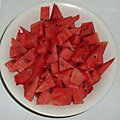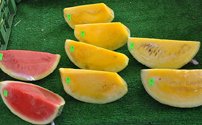Selection and storage
Although watermelons can be grown in all seasons in tropical environments, they are at their best during the summer months. In the
markets, try to buy organically grown melons since they are richer in taste and nutrients.
Oftentimes, it is hard to judge ripeness and taste without checking a wedge section of the melon. Look for one that is heavy for its size, featuring a rind that is relatively smooth, neither overly shiny nor overly dull, without any cuts or bruises on its surface that might have occurred during transportation.
Once at home, place the fruit in a cool, well-ventilated place. The cut sections, however, should be kept in the refrigerator.
Preparation and serving method
Wash the whole melon in cold running water. You can also give a wet cloth mop to remove any surface dirt and insecticide/fungicide residues.
 |
 |
| Watermelon cubes. | Yellow-watermelon sections along with regular variety! Courtesy: Francisco. |
Depending upon the size that you desire, watermelon can be sliced, cubed, or scooped into balls.
Here are some serving tips:
-
Fresh watermelon should be eaten as it is, without any additions/seasonings to experience its delicious, natural, sweet taste.
-
Cubes or sections of the melon are a great addition to fruit salad. Top its wedges with cold chocolate cream and relish!
-
Jam, sorbet, fruit cocktail, and juice are some nutritious and delicious recipes you can make with melons.
-
The seeds are roasted and eaten as a snack in some Asian countries.
-
Its rind is used and eaten as a vegetable in some South American countries.
Safety profile
Allergy to watermelon is rare, and everyone can safely enjoy it. Its seeds generally discarded but cause no toxicity if ingested accidentally. (Disclaimer).
≺≺ Back to Fruits from Watermelon. Visit here for an impressive list of all varieties of fruits with complete illustrations of their nutrition facts and health benefits.
≺≺ Back to Home page.
Further Resources:
-
Stanford School of Medicine Cancer information Page-Nutrition to Reduce Cancer Risk.

